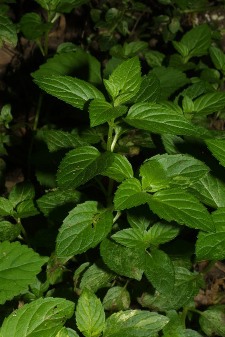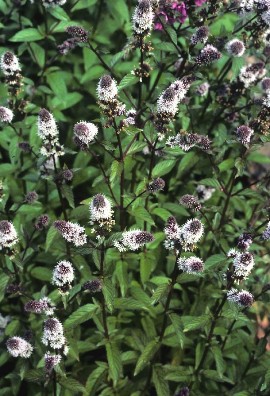Nutrition
PRODUCTION
Mentha x piperita is a photoautotroph. Photoautotrophs, typically plants, transform sunlight (radiant energy) to ATP (chemical energy) to produce complex organic molecules from simple inorganic molecules. Organic molecules that are produced are glucose (C6H12O6) or starch. Inorganic molecules are carbon dioxide (CO2) or water (H20).
The process in which complex molecules are made to produce energy is known as photosynthesis. Photosynthesis can either be anoxygenic (without oxygen) or oxygenic (with oxygen). Mentha x piperita goes through oxygenic photosynthesis. The equation for photosynthesis is as followed:
6CO2 + 6H20 + sun light --» C6H12O6 + 6O2 (+ H20)
 In order for the process of photosynthesis to
occur an organism must have a chloroplast. A chloroplast is an
organelle that is only found in plants. The chloroplast contains
the pigment chlorophyll, which aides in absorption of sun light.
If you wish to learn more about the process of photosynthesis
click here.
In order for the process of photosynthesis to
occur an organism must have a chloroplast. A chloroplast is an
organelle that is only found in plants. The chloroplast contains
the pigment chlorophyll, which aides in absorption of sun light.
If you wish to learn more about the process of photosynthesis
click here.
The amount of water and light a plant receives (or doesn't receive) can affect the photosynthetic output of oxygen and glucose. The size of of the leaves can show how plants have adapted to sunlight. If the leaf size is big, the plant receives low sunlight. In order to get the most out of the sunlight plant has adapted to having larger leaves that will allow for more surface area. If the leaf size is small, the plant receives high sunlight, therefore; it does not to have as much surface area because they already receive enough light.
TRANSPORTATION
Mentha x piperita is in the subkingdom Tracheobionta; this means it is a vascular plant. Vascular plants contain complex vascular tissues that make up a the phloem and the xylem. These structures help transport water, minerals, and food up and down the plant. Phloem specifically transports sugars and food, while the xylem transports water and dissolved minerals.
XYLEM
As stated, xylem transport water up the plant. Water has
certain properties that help water flow reach the top of the
plant. The first fact about water is that it moves from an area
of high water potential or low solute concentrations to an area
of low water potential or high solute concentration. A simpler
way to look at it, water moves from where there is a lot of it
to an area where there is less or it. One property of water is
cohesion. Cohesion is when water molecules stick to one another;
they stick to each other because water is highly polar. Adhesion
is another property in which the high affinity water molecules
attach to other polar molecules like cellulose cell walls. One
trait of water that is not necessarily a property is that it
(water) has a tendency to be drawn into small diameter tubes
(like the xylem). This capillarity trait is a combination of
cohesion and adhesion.
When it comes to water flowing up the xylem it follows the
following steps:
Transpiration -
water being evaporated through the leaves
Adhesion - water molecules stick to cellulose cell walls
Cohesion - water molecules stick to themselves forming a chain
Tension -
the newly formed water molecule chains being stretched
up the xylem

PHLOEM
Phloem cells consist of the following: sieve tube members, sieve plates, companion cells, and parenchyma cells. These components aide in the transportation of sugars and other foods down the stem. All of these phloem cells are made via mitosis, therefore; all the cells are the similar, being called sister cells.
Every year plants grow larger, when the plants grow they are essentially developing new layers of xylem and phloem. Each new layer rises via the vascular cambium. The vascular cambium comes from the procambium which is vascular tissue that comes from primary meristems. As the new layers are formed the old layers are no longer functional.
Osmosis and osmotic potential is how sugar is transported through the phloem. Osmosis is when you have two solutions that are connected and one is highly concentrated (with solutes) while the other is not. In this case the concentrations move (via osmosis) to reach an equilibrium (an equal amount of concentrations in both solutions). Because sugar is produced in the leaves there is also a high concentration in the leaves and lower concentration in the roots. Sugar is constantly being produced, therefore; osmosis is always occurring. Where sugar is being added is called "the source," the sugar then flows down the stem into the roots like "a sink."
**This same processes happens in all vascular organisms,
however; some larger organisms like the
Virginia Pine Tree may have more complex xylem and phloem.
They may be more complex because they grow to be much larger.